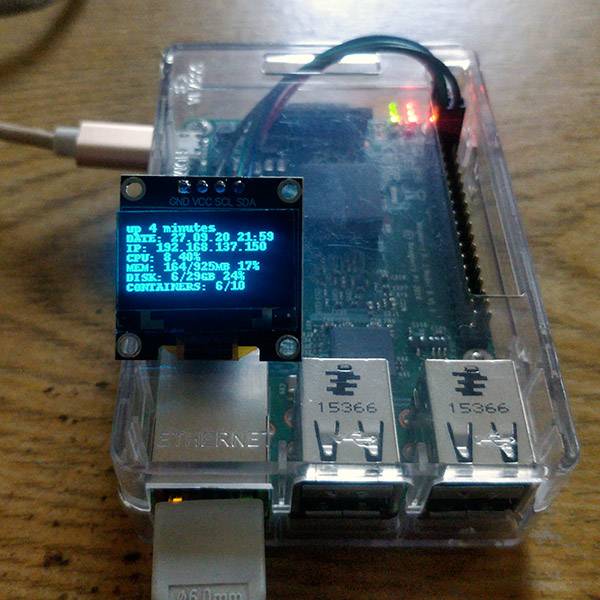my hw
Display: OLED SSD1306 128x64 (4 pins)
Raspberry:
cat /proc/device-tree/model
#> Raspberry Pi 2 Model B Rev 1.1
uname -r
#> 5.4.51-v7+
cat /etc/os-release | grep PRETTY_NAME
#> Raspbian GNU/Linux 10 (buster)upgrade to latest Raspbian and install python3
sudo apt update
sudo apt upgrade
sudo apt install python3 python3-pip
sudo pip3 install --upgrade setuptools
python --version
#> Python 2.7.16
# set default python version, must be python3
sudo update-alternatives --install /usr/bin/python python $(which python2) 1
sudo update-alternatives --install /usr/bin/python python $(which python3) 2
sudo update-alternatives --config python
python --version
#> Python 3.7.3
pip3 --version
#> pip 18.1 from /usr/lib/python3/dist-packages/pip (python 3.7)enable i2c on kernel
sudo raspi-config
## Interfacing Options -> I2C
## enable? -> YES
# check kernel module to load
cat /etc/modules | grep i2c
#> i2c-dev
sudo rebootconnect OLED to Raspberry
!!! use 3V (PIN 1), not 5V (PIN 2, PIN 4), its more safely for OLED.
| Raspberry Pi | OLED |
|---|---|
| Ground (PIN 6) | GND |
| 3V3 power (PIN 1) | VCC |
| GPIO 3 (PIN 5) | SCL |
| GPIO 2 (PIN 3) | SDA |
test i2c
# check i2c-dev
ls /dev/i2c*
#> /dev/i2c-1
sudo apt install python-smbus i2c-tools
i2cdetect -y 1
#> 0 1 2 3 4 5 6 7 8 9 a b c d e f
#> 00: -- -- -- -- -- -- -- -- -- -- -- -- --
#> 10: -- -- -- -- -- -- -- -- -- -- -- -- -- -- -- --
#> 20: -- -- -- -- -- -- -- -- -- -- -- -- -- -- -- --
#> 30: -- -- -- -- -- -- -- -- -- -- -- -- 3c -- -- --
#> 40: -- -- -- -- -- -- -- -- -- -- -- -- -- -- -- --
#> 50: -- -- -- -- -- -- -- -- -- -- -- -- -- -- -- --
#> 60: -- -- -- -- -- -- -- -- -- -- -- -- -- -- -- --
#> 70: -- -- -- -- -- -- -- --
# address is 0x3C
# for older models (256mb) change port to 0
#i2cdetect -y 0install SSD1306 driver
sudo pip3 install adafruit-circuitpython-ssd1306
sudo apt install python3-pilwrite code
oled_stats.py:
#!/usr/bin/env python3
import time
import subprocess
from board import SCL, SDA
import busio
from PIL import Image, ImageDraw, ImageFont
import adafruit_ssd1306
i2c = busio.I2C(SCL, SDA)
disp = adafruit_ssd1306.SSD1306_I2C(128, 64, i2c)
disp.fill(0)
disp.show()
image = Image.new("1", (disp.width, disp.height))
draw = ImageDraw.Draw(image)
font_height = 8
font = ImageFont.load_default()
line = 0
def clear_screen():
global line
line = 0
draw.rectangle((0, 0, disp.width, disp.height), outline=0, fill=0)
def draw_line(text):
global line
draw.text((0, font_height * line), text, font=font, fill=255)
line = line + 1
#print(text)
def shell(cmd):
return subprocess.check_output(cmd, shell=True).decode("utf-8")
while True:
clear_screen()
uptime = shell("""uptime -p | tr -d '\n'""")
date = shell("""date +'%d.%m.%y %H:%M' | tr -d '\n'""")
ip = shell("""hostname -I | awk '{printf "%s",$1}'""")
cpu = shell("""top -b -n1 | grep 'Cpu(s)' | awk '{printf "%.2f%%",$2+$4}'""")
mem = shell("""free -m | awk 'NR==2{printf "%s/%sMB %d%%",$3,$2,$3*100/$2 }'""")
disk = shell("""df -h | awk '$NF=="/"{printf "%d/%dGB %s",$3,$2,$5}'""")
docker = shell("""echo "$(docker ps -q | wc -l)/$(docker ps -q -a | wc -l)" | tr -d '\n'""")
# draw lines
draw_line(uptime)
draw_line("DATE: " + date)
draw_line("IP: " + ip)
draw_line("CPU: " + cpu)
draw_line("MEM: " + mem)
draw_line("DISK: " + disk)
draw_line("CONTAINERS: " + docker)
# display image
disp.image(image)
disp.show()
# update every 5 sec
time.sleep(5)run it
chmod +x oled_stats.py
./oled_stats.py
#> up 1 hour, 14 minutes
#> DATE: 27.09.20 21:16
#> IP: 192.168.137.150
#> CPU: 7.20%
#> MEM: 284/925MB 30%
#> DISK: 6/29GB 24%
#> CONTAINERS: 10/10run on boot
add to /etc/rc.local:
./home/pi/oled_stats.py &enjoy!
